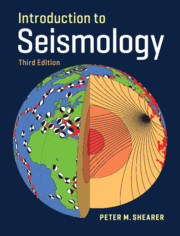56 results
Children in foster care with symptoms of reactive attachment disorder: feasibility randomised controlled trial of a modified video-feedback parenting intervention
-
- Journal:
- BJPsych Open / Volume 8 / Issue 4 / July 2022
- Published online by Cambridge University Press:
- 18 July 2022, e134
-
- Article
-
- You have access
- Open access
- HTML
- Export citation
Appendix D - Python Functions
-
- Book:
- Introduction to Seismology
- Published online:
- 07 May 2020
- Print publication:
- 30 May 2019, pp 381-386
-
- Chapter
- Export citation
Index
-
- Book:
- Introduction to Seismology
- Published online:
- 07 May 2020
- Print publication:
- 30 May 2019, pp 419-424
-
- Chapter
- Export citation
5 - Inversion of Travel Time Data
-
- Book:
- Introduction to Seismology
- Published online:
- 07 May 2020
- Print publication:
- 30 May 2019, pp 99-136
-
- Chapter
- Export citation
Brief Contents
-
- Book:
- Introduction to Seismology
- Published online:
- 07 May 2020
- Print publication:
- 30 May 2019, pp v-viii
-
- Chapter
- Export citation
Acknowledgments
-
- Book:
- Introduction to Seismology
- Published online:
- 07 May 2020
- Print publication:
- 30 May 2019, pp xvii-xviii
-
- Chapter
- Export citation
7 - Reflection Seismology and Related Topics
-
- Book:
- Introduction to Seismology
- Published online:
- 07 May 2020
- Print publication:
- 30 May 2019, pp 175-208
-
- Chapter
- Export citation

Introduction to Seismology
-
- Published online:
- 07 May 2020
- Print publication:
- 30 May 2019
-
- Textbook
- Export citation
6 - Ray Theory: Amplitude and Phase
-
- Book:
- Introduction to Seismology
- Published online:
- 07 May 2020
- Print publication:
- 30 May 2019, pp 137-174
-
- Chapter
- Export citation
9 - Earthquakes and Source Theory
-
- Book:
- Introduction to Seismology
- Published online:
- 07 May 2020
- Print publication:
- 30 May 2019, pp 237-298
-
- Chapter
- Export citation
Bibliography
-
- Book:
- Introduction to Seismology
- Published online:
- 07 May 2020
- Print publication:
- 30 May 2019, pp 403-418
-
- Chapter
- Export citation
13 - Anisotropy
-
- Book:
- Introduction to Seismology
- Published online:
- 07 May 2020
- Print publication:
- 30 May 2019, pp 341-364
-
- Chapter
- Export citation
Appendix C - The Eikonal Equation
-
- Book:
- Introduction to Seismology
- Published online:
- 07 May 2020
- Print publication:
- 30 May 2019, pp 377-380
-
- Chapter
- Export citation
4 - Ray Theory: Travel Times
-
- Book:
- Introduction to Seismology
- Published online:
- 07 May 2020
- Print publication:
- 30 May 2019, pp 63-98
-
- Chapter
- Export citation
Preface
-
- Book:
- Introduction to Seismology
- Published online:
- 07 May 2020
- Print publication:
- 30 May 2019, pp xv-xvi
-
- Chapter
- Export citation
Appendix A - The PREM Model
-
- Book:
- Introduction to Seismology
- Published online:
- 07 May 2020
- Print publication:
- 30 May 2019, pp 365-368
-
- Chapter
- Export citation
2 - Stress and Strain
-
- Book:
- Introduction to Seismology
- Published online:
- 07 May 2020
- Print publication:
- 30 May 2019, pp 19-38
-
- Chapter
- Export citation
Appendix F - Kirchhoff Theory
-
- Book:
- Introduction to Seismology
- Published online:
- 07 May 2020
- Print publication:
- 30 May 2019, pp 393-402
-
- Chapter
- Export citation
8 - Surface Waves and Normal Modes
-
- Book:
- Introduction to Seismology
- Published online:
- 07 May 2020
- Print publication:
- 30 May 2019, pp 209-236
-
- Chapter
- Export citation
1 - Introduction
-
- Book:
- Introduction to Seismology
- Published online:
- 07 May 2020
- Print publication:
- 30 May 2019, pp 1-18
-
- Chapter
- Export citation



